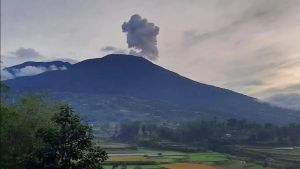
JAKARTA - The Indonesian government through the Ministry of Environment and Forestry (KLHK) stated that scientific data is always based on addressing cross-border smoke that crosses into neighboring countries.
The statement was made by the Director General of Climate Change Control of the Ministry of Environment and Forestry, Laksmi Dbahthi, regarding the handling of forest and land fires which was held at the KLHK Park.
"We are monitoring using ASMC data operated in Singapore, as well as BMKG with Himawari," he said, quoted by ANTARA, Saturday, October 7.
Laksmi said that through information from the two institutions, his party could confirm data on cross-border smoke from Indonesia that crossed into neighboring countries.
"We didn't monitor how the smoke was there and where it came from, but what we saw was really data-based because everything we did had to be science and data-based, so that later we could easily trace and easily prove it," he explained.
The Indonesian government uses data from The ASEAN Specialized Meteorological Center (ASMC) and Himawari satellite imagery operated by the Meteorology, Climatology and Geophysics Agency (BMKG) to see the spread of smoke to neighboring countries.
Based on data from ASMC and BMKG, the Ministry of Environment and Forestry stated that until this morning there was no detectable cross-border smoke from Indonesian areas that were experiencing forest and land fires, namely South Sumatra, Jambi, South Kalimantan, and Central Kalimantan.
Laksmi said the data was open and accessible to anyone, so that everyone could see whether smoke crossed into neighboring countries or not.
Regarding letters from the Malaysian Government that offer cooperation and assistance, he added, Indonesia and Malaysia as fellow ASEAN member countries already have an ASEAN Agreement on Transboundary Haze Pollution or ASEAN Agreement on Cross-Batas Smoke Pollution.
The agreement has several steps ranging from monitoring and assessment measures, prevention, preparedness, emergency response at the national level, mutual emergency response at the regional level. Then, procedures for placing people, materials, cross-border equipment and technical cooperation.
"We are following these steps. Currently in Indonesia we are making various emergency response efforts," said Laksmi.
Fellow ASEAN members refer to the same data and resources. Cooperation mechanisms will of course be followed according to existing ones.
However, based on existing agreements, each country must make efforts to prepare and respond to an emergency at the national level before then switching to an emergency response at the regional level.
There are seven provinces in Indonesia that have set emergency alert for forest and land fires, namely Riau, Jambi, South Sumatra, West Kalimantan, Central Kalimantan, South Kalimantan, and East Nusa Tenggara.
관련 항목:
The Indonesian government did not make efforts to control forest and land fires only to respond after the fire broke out, then the fire was extinguished.
A permanent solution is made so that forest and land fires do not become a routine cycle every year.
Three permanent solutions are climate and weather analysis, capacity strengthening of the field team, and landscape management.
Director General of Environmental and Forestry Law Enforcement KLHK Rasio Ridho Sani said his party had sealed 35 burned lands with details of 11 lands in West Kalimantan, 10 lands in Central Kalimantan, and 14 lands in South Sumatra. The majority of the land that was sealed was oil palm plantations.
"We also do not hesitate to revoke permits for land that has been burned repeatedly," concluded Rasio.
The English, Chinese, Japanese, Arabic, and French versions are automatically generated by the AI. So there may still be inaccuracies in translating, please always see Indonesian as our main language. (system supported by DigitalSiber.id)
















